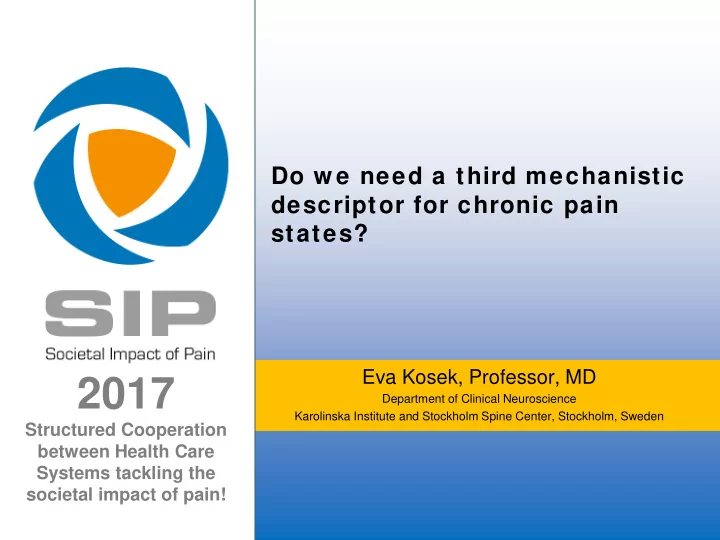

Do w e need a third mechanistic descriptor for chronic pain states? Eva Kosek, Professor, MD 2017 Department of Clinical Neuroscience Karolinska Institute and Stockholm Spine Center, Stockholm, Sweden Structured Cooperation between Health Care Systems tackling the societal impact of pain!
Disclosure Statement of conflict of interest in the context of the subject of this presentation Within the past 12 months, I or my spouse/partner have had following financial interest/arrangement(s) or affiliation(s) below. • Support for travel …NA………………… • Honoraria for lectures …NA………………… • Honoraria for advisory board activities …NA………………… • Participation in clinical trials …NA………………… • Research funding Eli Lilly, Abbevie • Financial shares and options …NA………………… • …………………………….. ……………………
Symptom Disease Pain
Symptom Disease • Nociceptive pain Pain – Pain that arises from ? actual or threatened damage to non-neural tissue and is due to the activation of nociceptors • Neuropathic pain – Pain caused by a lesion Altered nociceptive function or disease of the somatosensory nervous system
Problems with current pain terminology • Large groups of chronic pain patients are difficult to classify as having nociceptive or neuropathic pain • Many of these patients have pain conditions characterized by altered nociceptive function • Currently clinicians and scientists use ”home- made” terminology causing confusion • Revision needed
Kosek, Cohen et al. Pain 2016;157:1382-86
Third mechanistic descriptor • Needed for large patient groups with altered nociception not fullfilling criteria for nociceptive or neuropathic pain – No clear evidence of actual or threatened tissue damage causing the activation of peripheral nociceptors causing the pain – No evidence for disease or lesion of the somatosensory system causing the pain – Presence of hypersensitivity
Altered nociceptive processing • Hypersensitivity documented by: – quantitative sensory testing 1-7 – sensory evoked potentials 8-10 – functional magnetic resonance imaging 7, 11-13 • Altered nociception related to pain severity 14-17 1) Blumenstiel K et al. Clin J Pain 2011;27:682–90, 2) Gierthmuühlen et al. PAIN 2012;153:765–74, 3) Kosek et al. PAIN 1996;68:375–83, 4) Kosek E and Ordeberg G. PAIN 2000;88:69–78, 5) Puta et al. PLoS One 2013;8:e58885, 6) van Rooijen et al. PAIN 2013;154:2745–9, 7) Wilder-Smith Gut 2011;60:1589–99, 8) Diers et al. Clin Neurophysiol 2007;24:76–83, 9) Diers et al. J Clin Neurophysiol 2008;25:153–60, 10) Lorenz et al. Electroencephalography Clin Neurophysiol 1996;100:165–8, 11) Giesecke et al. Arthritis Rheum 2004;50:613–23, 12) Jensen et al. PAIN 2009;144:95–100, 13) Maihöfner PAIN 2005;114:93– 103, 14) Apkarian et al. J Neurosci 2004;24:10410–5, 15) Kuchinad et al. J Neurosci 2007;27:4004–7, 16) Napadow et al. Arthritis Rheum 2010;62:2545–55, 17) Schmidt-Wilcke et al. Pain Med 2014;15:1346–58.
When to use the third descriptor • The term is intended for clinical usage for patients presenting with pain and hypersensitivity with clinical and psychophysical findings that suggest altered nociceptive function. • Typical such patient groups include: – fibromyalgia – complex regional pain syndrome (CRPS) type 1 – other instances of ‘musculoskeletal’ pain (such as ‘non- specific’ chronic low back pain – 'functional' visceral pain disorders (such as irritable bowel syndrome, bladder pain syndrome)
Pain classification problems Nociceptive pain Central sensitisation Disinhibition Facilitation Development of a set of clinically When does nociceptive pain useful positive turn into nociplastic/ classification criteria algopathic pain? is ongoing
Third mechanistic descriptor could • Confer validity on the patient’s experience of pain and facilitate communication • Encourage clinicians to screen for signs of altered nociceptive function, thus improving diagnosis and treatment • Facilitate research efforts, establishment of treatment guidelines and development of new treatment strategies • Have an impact on drug regulatory issues
Question to audience: Which would you prefer nociplastic or algopathic?
Recommend
More recommend